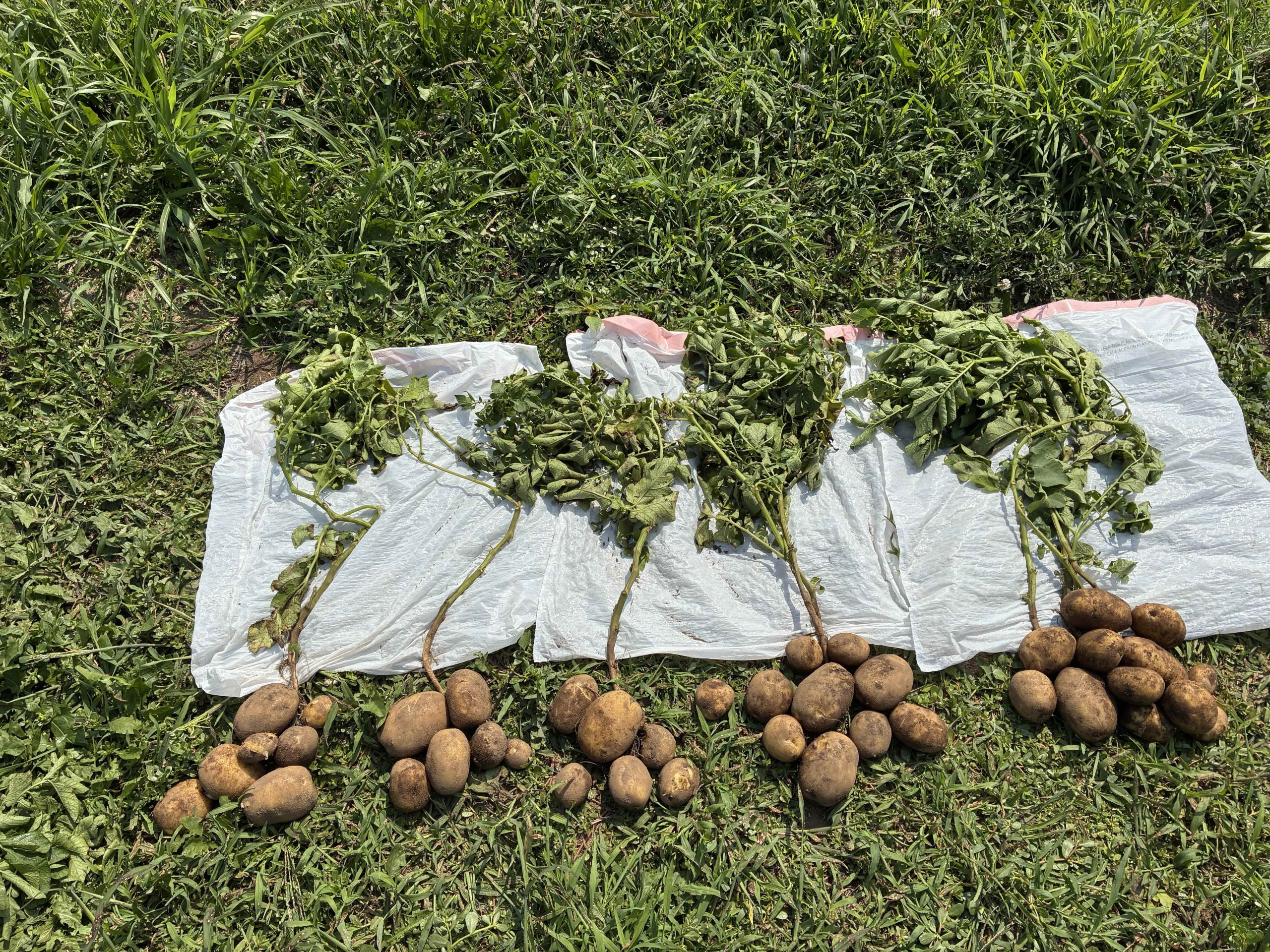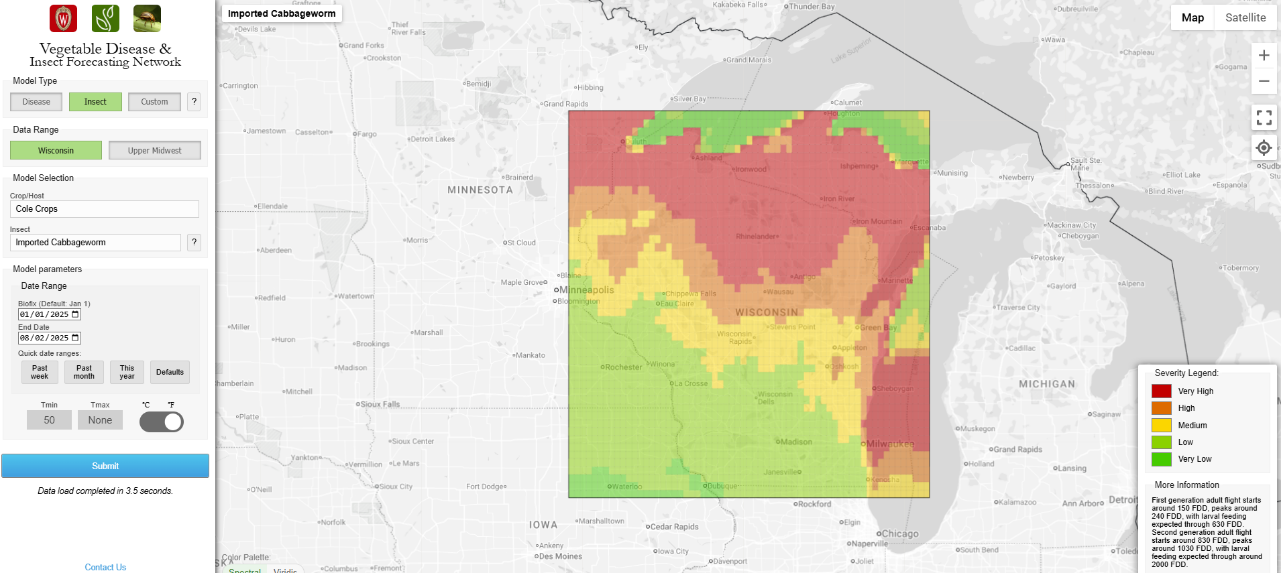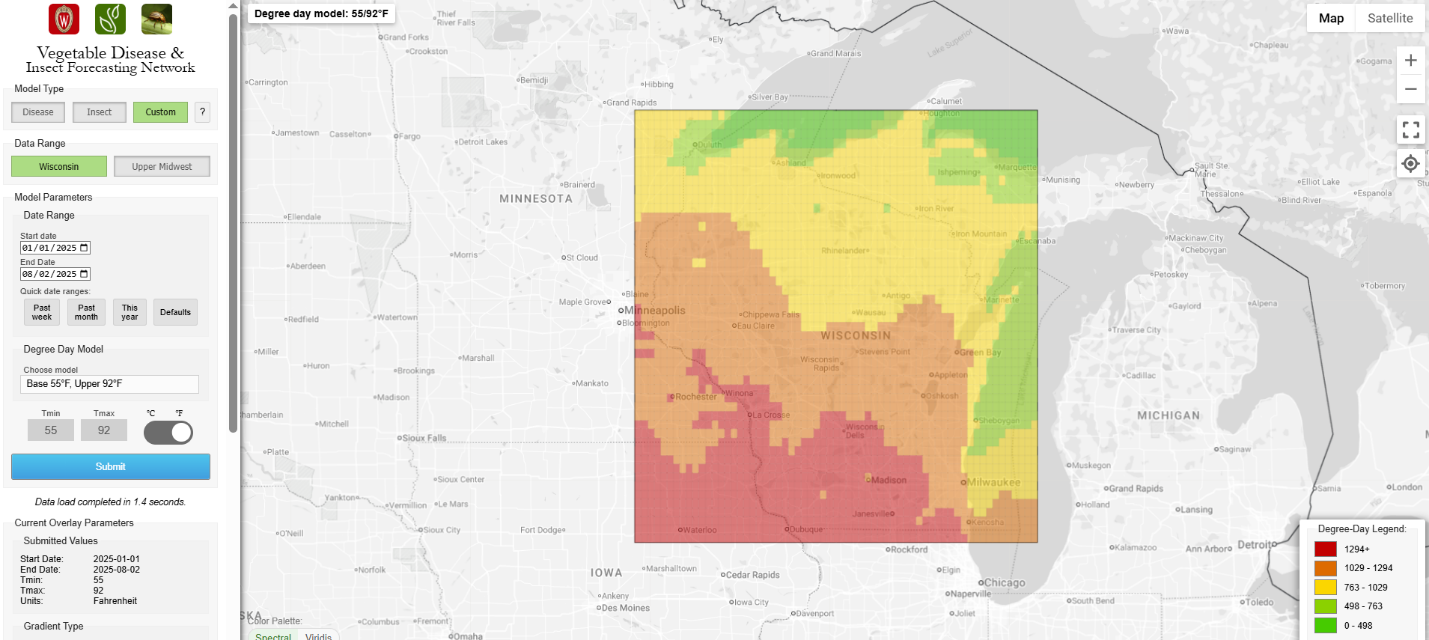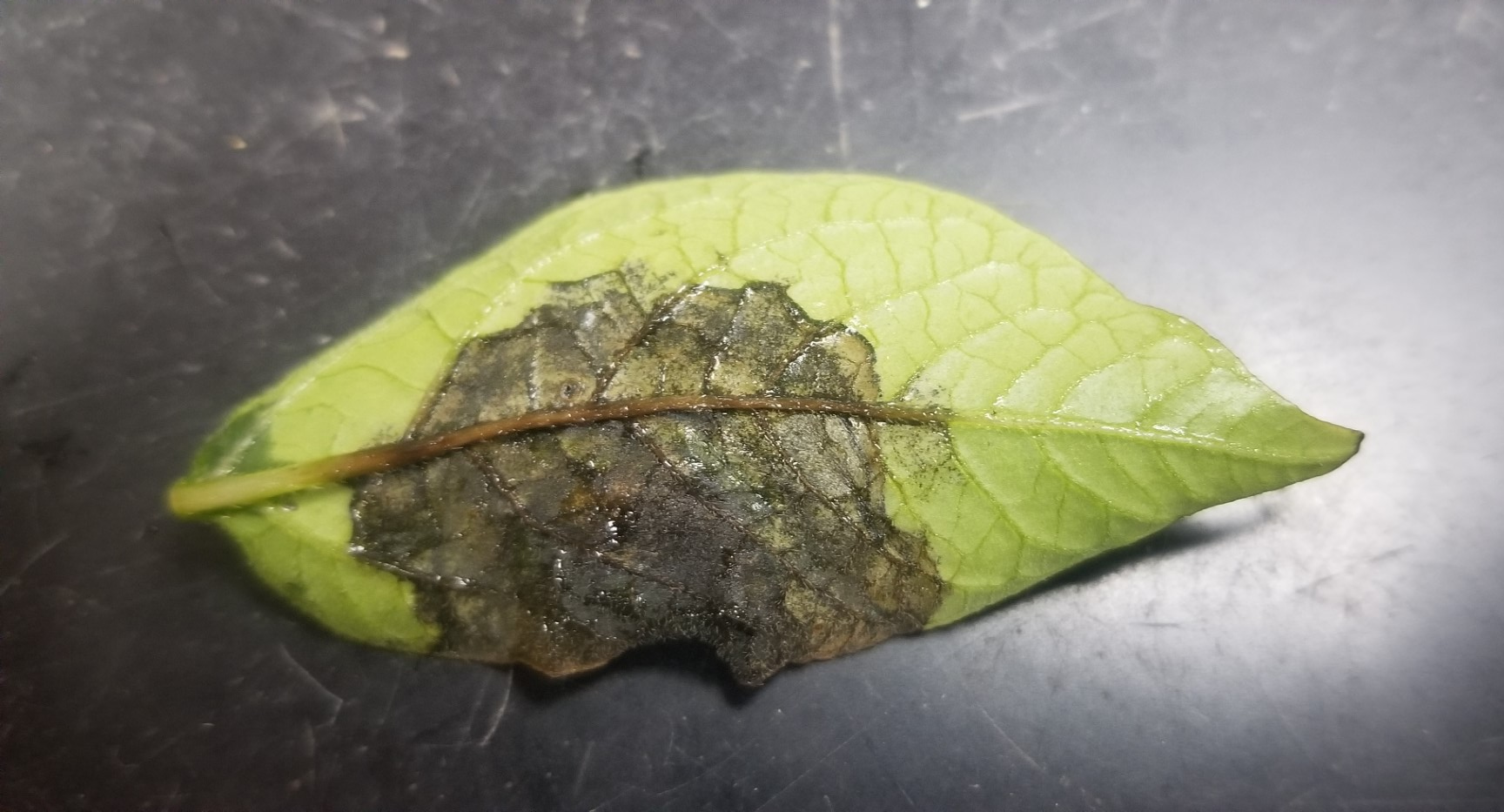
In this issue:
- Potato production updates and weather review
- Imported Cabbage Worm and Squash Bug updates and management
- Disease forecasting updates for potato early blight and late blight
- Cucurbit downy mildew updates
- Nicotianae blight of potato – a late blight ‘look alike’
Yi Wang, Associate Professor & Extension Potato and Vegetable Production Specialist, UW-Madison, Dept. of Plant and Agroecosystem Sciences, 608-265-4781, Email: wang52@wisc.edu.
According to the Division of Extension Crops and Soils 2025 Weather Outlook, most of the state received half an inch or more of rainfall over the past week. Higher totals of 2-4’’ were noted near Eau Claire. In the whole of July, spottier thunderstorms in south and north Central WI have led to below normal precip amounts in those regions. But overall, drought has been eliminated in WI, with the lowest drought area/severity since July 2024. Warmer-than-average temperatures were observed throughout the state last week, with some days exceeding 90°F. The heat was similar to the beginning of July, with a slight cool-down in the middle of the month. For next week, it will generally be drier for much of the state, except for the southern region. Climate probabilities for early August show a leaning towards above-normal temperatures throughout the state (40-50% likelihood). The outlook for the entire August hints at the possibility of warmer-than-average temperatures.
Nationally, potato yield looks great out west this year, with good water level and close to optimal growing conditions. Folks from Idaho have predicted a higher-than-average yield that leads to a plentiful supply and low farm-level prices. Quality looks great so far too.
My team did a final hand digging of five plants (Figure below) from the commercial Colomba field yesterday. This field was planted in mid-April and will be vine-killed soon. Per plant tuber set is 8. Specific gravity is 1.062. Individual tuber weight distribution is shown in the bar chart below. About 65% of the tubers that were dug had a weight higher than 3oz. The estimated total yield of this field is about 400 cwt/acre.

Vegetable Insect Update – Russell L. Groves, Professor, UW-Madison, Department of Entomology, 608-262-3229 (office), (608) 698-2434 (cell), e-mail: rgroves@wisc.edu Vegetable Entomology Webpage: https://vegento.russell.wisc.edu/
Imported cabbageworm. (https://vegento.russell.wisc.edu/pests/caterpillar-pests-of-cole-crops/). Imported cabbageworm adults, commonly referred to as the white cabbage butterfly, are white butterflies with black markings on the wing tips. Adult butterflies have emerged from the recently completed second generation across much of southern Wisconsin. These insects are expected to mate and complete a 3rd generation through the month of August. Large larvae are still present in susceptible cole crops (broccoli, cauliflower, cabbage, kohlrabi, kale, etc.) in portions of northcentral and northern Wisconsin. Female butterflies have 2 black dots on each fore wing; males, which are smaller, have 1 dot per wing. An adult butterfly can lay 300 to 400 eggs in her lifetime. Larvae appear as velvety green worms up to 1 inch long with a faint yellow stripe running down the back. The caterpillar is commonly found along the veins of leaves and easily blends into the foliage.
Imported cabbageworms overwinter can produce 3-6 generations in a single season. Butterflies emerge in early May and begin laying single, small, yellow-orange eggs on the undersurface of leaves. The caterpillar feeds and develops for approximately 11 to 20 days before forming a pupa from which the adult butterfly emerges after 6 to 11 days. Second generation butterflies emerge late-July and this generation causes the most damage.

Scout fields weekly for damage. Check plants carefully, even if no feeding damage is apparent, to look for eggs that will hatch into small caterpillars in the coming days as adults are abundant in fields at this time. Although feeding damage and fecal material are signs of activity, it is better to rely on larvae counts to determine the level of infestation. Caterpillars cause varying amounts of damage depending on the plant’s maturity, so the need for treatment changes as the crop grows.
Squash bug – (https://vegento.russell.wisc.edu/pests/squash-bug/). Squash bugs are an emerging problem in Wisconsin. In recent years, these insects have become more prevalent, causing damage to vine crops in commercial fields and home gardens alike. The key to management is early detection. Squash bugs feed on all vine crops, but pumpkins and squash are the preferred hosts with gourds and melons favored next. Unmated adults overwinter in Wisconsin in protected areas. Eggs are laid in late June and early July when cucurbit vines begin to develop. Eggs hatch in about 10 days. The nymphal stage lasts 4-6 weeks and nymphs undergo 5 molts before reaching maturity. Adults appear in late July and early August.

Adult populations have become very abundant in the past 7-10 days, and because they are protected by the lower surfaces of leaves, squash bugs may be difficult to observe and control. Although it is unlikely to find large populations of the adult or nymphal bugs early in the season, growers should check their transplants or new seedlings for the presence of adults. Using a base temperature of 55°F, eggs will appear at 193 DD and nymphs will emerge at 554 DD. The threshold for treatment is one egg mass per plant during flowering.

Amanda Gevens, Professor & Extension Vegetable Pathologist, UW-Madison, Dept. of Plant Pathology, 608-575-3029, gevens@wisc.edu, Lab Website: https://vegpath.plantpath.wisc.edu/.
Current P-Day (Early Blight) and Disease Severity Value (Late Blight) Accumulations will be posted at our website and available in the weekly newsletters. Thanks to Ben Bradford, UW-Madison Entomology for supporting this effort and providing a summary reference table: https://agweather.cals.wisc.edu/thermal-models/potato. A Potato Physiological Day or P-Day value of ≥300 indicates the threshold for early blight risk and triggers preventative fungicide application. A Disease Severity Value or DSV of ≥18 indicates the threshold for late blight risk and triggers preventative fungicide application. Data from the modeling source: https://agweather.cals.wisc.edu/vdifn are used to generate these risk values in the table below. I’ve estimated early, mid-, and late planting dates by region based on communications with stakeholders. These are intended to help in determining optimum times for preventative fungicide applications to limit early and late blight in Wisconsin.
|
|
Planting Date | 50% Emergence Date | Disease Severity Values (DSVs)
through 8/2/2025 |
Potato Physiological Days (P-Days)
through 8/2/2025 |
|
| Spring Green | Early | Apr 5 | May 10 | 39 | 656 |
| Mid | Apr 18 | May 14 | 39 | 628 | |
| Late | May 12 | May 26 | 36 | 571 | |
| Arlington | Early | Apr 5 | May 10 | 31 | 656 |
| Mid | Apr 20 | May 15 | 31 | 619 | |
| Late | May 10 | May 24 | 28 | 583 | |
| Grand Marsh | Early | Apr 7 | May 11 | 36 | 638 |
| Mid | Apr 17 | May 14 | 36 | 618 | |
| Late | May 12 | May 27 | 36 | 564 | |
| Hancock | Early | Apr 10 | May 15 | 37 | 607 |
| Mid | Apr 22 | May 21 | 37 | 581 | |
| Late | May 14 | June 2 | 37 | 526 | |
| Plover | Early | Apr 14 | May 18 | 32 | 583 |
| Mid | Apr 24 | May 22 | 32 | 581 | |
| Late | May 19 | June 7 | 32 | 483 | |
| Antigo | Early | May 1 | May 24 | 34 | 543 |
| Mid | May 15 | June 1 | 34 | 501 | |
| Late | June 1 | June 15 | 29 | 418 | |
| Rhinelander | Early | May 7 | May 25 | 24 | 518 |
| Mid | May 18 | June 8 | 24 | 443 | |
| Late | June 2 | June 16 | 20 | 400 | |
Late blight of potato/tomato. In the US, late blight has been confirmed in both Pennsylvania and New York in the past week or so. This outbreak has affected both tomato and potato crops. This follows after the July 17 Dufferin County Ontario Canada finding, which was confirmed as US-23 Phytophthora infestans (still sensitive to mefenoxam/metalaxyl (ie: Ridomil). https://onvegetables.com/2025/07/17/late-blight-update-july-17th-2025/ Cornell Extension has reported late blight confirmations on potatoes and tomatoes in western NY following the July 18th finding. https://www.wrfalp.com/late-blight-found-in-cattaraugus-county-affects-tomatoes-potatoes/
Here in Wisconsin, we saw the accumulation of just 0-6 DSVs across WI this past week, with the greatest accumulations in the southern part of the date. All plantings of potatoes in Wisconsin have surpassed the Blitecast threshold of 18 DSVs and should receive preventative fungicides for the management of late blight. Please find a fungicide listing for Wisconsin potato late blight management: https://vegpath.plantpath.wisc.edu/documents/potato-late-blight-fungicides/
Early blight of potato. Accumulations of P-Days were 50-61 over the past week, with P-Day 300 thresholds met for preventative fungicide treatment in potatoes across all of Wisconsin. The earliest inoculum of Alternaria solani typically comes from within a field and from nearby fields. Once established, early blight continues to create new infections due to its polycyclic nature – meaning spores create foliar infection and the resulting lesion on the plant can then produce new spores for ongoing new infections in the field and beyond. Early-season management of early blight in potato can mitigate the disease for the rest of the season, especially since the earlier sprays tend to get best coverage and potential control of early infection. Early blight is active in central and southern WI. https://vegpath.plantpath.wisc.edu/diseases/potato-early-blight/
Fungicides can provide good control of early blight in vegetables when applied early in infection. Multiple applications of fungicide are often necessary to sustain disease management to the time of harvest due to the typically high abundance of inoculum and susceptibility of most common cultivars. For Wisconsin-specific fungicide information, please refer to the Commercial Vegetable Production in Wisconsin (A3422), a guide available here: https://cropsandsoils.extension.wisc.edu/articles/2025-commercial-vegetable-production-in-wisconsin-a3422/
For custom values, please explore the UW Vegetable Disease and Insect Forecasting Network tool for P-Days and DSVs across the state (https://agweather.cals.wisc.edu/vdifn). This tool utilizes NOAA weather data. Be sure to enter your model selections and parameters, then hit the blue submit button at the bottom of the parameter boxes. Once thresholds are met for risk of early blight and/or late blight, fungicides are recommended for optimum disease control. Fungicide details can be found in the 2025 Commercial Veg. Production in WI Extension Document A3422: https://cropsandsoils.extension.wisc.edu/articles/2025-commercial-vegetable-production-in-wisconsin-a3422/
Cucurbit Downy Mildew: This national cucurbit downy mildew information helps us understand the potential timing of arrival of the pathogen, Pseudoperonospora cubensis, in our region, as well as the strain type which can give us information about likely cucurbit hosts in WI – as well as best management strategies. Clade 1 downy mildew strains infect watermelon and Clade 2 strains infect cucumber. I am hosting a cucurbit (and basil) downy mildew sentinel plot at the UW Hancock Agricultural Research Station this summer. This ‘sentinel plot’ is a non-fungicide-treated collection of cucurbit plants observed weekly for disease symptoms. No downy mildew was seen on cucurbits this past week at HARS. Additionally, I keep an eye on the downy mildew work of Dr. Mary Hausbeck at Michigan State University and include this information as relevant to WI https://veggies.msu.edu/downy-mildew-news/. This season, Clade 2 downy mildew spores were confirmed in several MI counties and downy mildew has been confirmed in commercial cucumber fields in several MI counties. The disease was also reported in northern Ohio, Pennsylvania, and North Carolina this past week on cucumber. The Cucurbit Downy Mildew ipm PIPE website still maintains current reports: https://cdm.ipmpipe.org/.
Late blight ‘look-alike’ noted in central Wisconsin potato. While Phytophthora nicotianae, a cousin to the late blight pathogen Phytophthora infestans, is typically a soilborne pathogen infecting roots and tubers (can cause ‘pink rot’), lesions can sometimes form on the foliage of tomato and potato (its host range includes citrus, tobacco and ornamentals). The presence of this ‘nicotianae blight’ indicates leaf wetness and higher temperatures and the lesions are often seen in potatoes along the irrigation pivot tracks. Phytophthora nicotianae can form overwintering soilborne structures known as oospores and chlamydospores. Foliar infections look menacingly like late blight, but the lesions do not exhibit sporulation (pictures below). It’s important to be aware of this disease and to have it diagnosed to confirm the underlying pathogen. Late blight is typically favored under cooler temperatures than P. nicotianae and does sporulate profusely, making spread much more challenging to control. Foliar fungicide programs which protect against late blight can also control ‘nicotianae blight’. More information can be found in a nice web article by Dr. Jean Ristaino, Amanda Saville, Inga Meadows, and Mary Lorscheider from North Carolina State University at: https://plantpathology.ces.ncsu.edu/2018/06/phytophthora-nicotianae-causing-severe-disease-on-potato-and-tomato-in-north-carolina/


